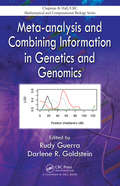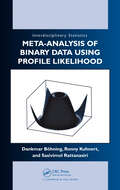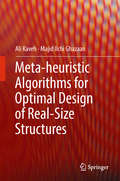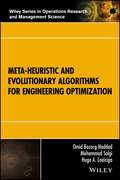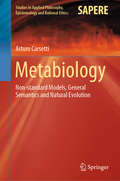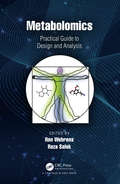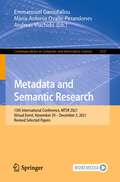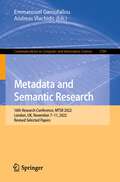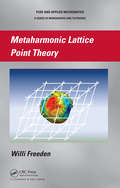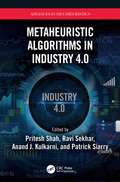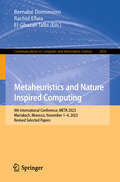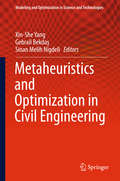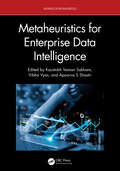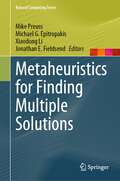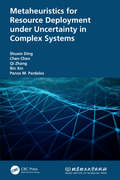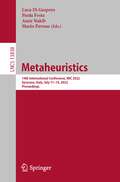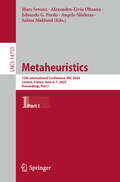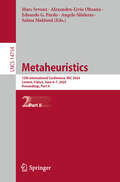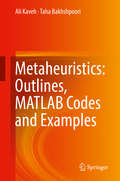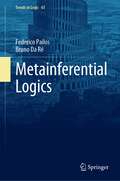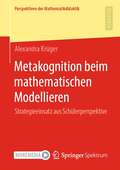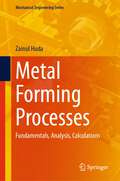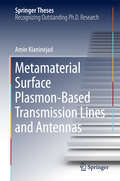- Table View
- List View
Meta-analysis and Combining Information in Genetics and Genomics (Chapman & Hall/CRC Computational Biology Series)
by Rudy Guerra Darlene R. GoldsteinNovel Techniques for Analyzing and Combining Data from Modern Biological StudiesBroadens the Traditional Definition of Meta-AnalysisWith the diversity of data and meta-data now available, there is increased interest in analyzing multiple studies beyond statistical approaches of formal meta-analysis. Covering an extensive range of quantitative infor
Meta-analysis of Binary Data Using Profile Likelihood (Chapman & Hall/CRC Interdisciplinary Statistics)
by Dankmar Bohning Sasivimol Rattanasiri Ronny KuhnertProviding reliable information on an intervention effect, meta-analysis is a powerful statistical tool for analyzing and combining results from individual studies. Meta-Analysis of Binary Data Using Profile Likelihood focuses on the analysis and modeling of a meta-analysis with individually pooled data (MAIPD). It presents a unifying approac
Meta-heuristic Algorithms for Optimal Design of Real-Size Structures
by Ali Kaveh Majid Ilchi GhazaanThe contributions in this book discuss large-scale problems like the optimal design of domes, antennas, transmission line towers, barrel vaults and steel frames with different types of limitations such as strength, buckling, displacement and natural frequencies. The authors use a set of definite algorithms for the optimization of all types of structures. They also add a new enhanced version of VPS and information about configuration processes to all chapters. Domes are of special interest to engineers as they enclose a maximum amount of space with a minimum surface and have proven to be very economical in terms of consumption of constructional materials. Antennas and transmission line towers are the one of the most popular structure since these steel lattice towers are inexpensive, strong, light and wind resistant. Architects and engineers choose barrel vaults as viable and often highly suitable forms for covering not only low-cost industrial buildings, warehouses, large-span hangars, indoor sports stadiums, but also large cultural and leisure centers. Steel buildings are preferred in residential as well as commercial buildings due to their high strength and ductility particularly in regions which are prone to earthquakes.
Meta-heuristic and Evolutionary Algorithms for Engineering Optimization
by Omid Bozorg-Haddad Mohammad Solgi Hugo A. LoáicigaA detailed review of a wide range of meta-heuristic and evolutionary algorithms in a systematic manner and how they relate to engineering optimization problems This book introduces the main metaheuristic algorithms and their applications in optimization. It describes 20 leading meta-heuristic and evolutionary algorithms and presents discussions and assessments of their performance in solving optimization problems from several fields of engineering. The book features clear and concise principles and presents detailed descriptions of leading methods such as the pattern search (PS) algorithm, the genetic algorithm (GA), the simulated annealing (SA) algorithm, the Tabu search (TS) algorithm, the ant colony optimization (ACO), and the particle swarm optimization (PSO) technique. Chapter 1 of Meta-heuristic and Evolutionary Algorithms for Engineering Optimization provides an overview of optimization and defines it by presenting examples of optimization problems in different engineering domains. Chapter 2 presents an introduction to meta-heuristic and evolutionary algorithms and links them to engineering problems. Chapters 3 to 22 are each devoted to a separate algorithm— and they each start with a brief literature review of the development of the algorithm, and its applications to engineering problems. The principles, steps, and execution of the algorithms are described in detail, and a pseudo code of the algorithm is presented, which serves as a guideline for coding the algorithm to solve specific applications. This book: Introduces state-of-the-art metaheuristic algorithms and their applications to engineering optimization; Fills a gap in the current literature by compiling and explaining the various meta-heuristic and evolutionary algorithms in a clear and systematic manner; Provides a step-by-step presentation of each algorithm and guidelines for practical implementation and coding of algorithms; Discusses and assesses the performance of metaheuristic algorithms in multiple problems from many fields of engineering; Relates optimization algorithms to engineering problems employing a unifying approach. Meta-heuristic and Evolutionary Algorithms for Engineering Optimization is a reference intended for students, engineers, researchers, and instructors in the fields of industrial engineering, operations research, optimization/mathematics, engineering optimization, and computer science. OMID BOZORG-HADDAD, PhD, is Professor in the Department of Irrigation and Reclamation Engineering at the University of Tehran, Iran. MOHAMMAD SOLGI, M.Sc., is Teacher Assistant for M.Sc. courses at the University of Tehran, Iran. HUGO A. LOÁICIGA, PhD, is Professor in the Department of Geography at the University of California, Santa Barbara, United States of America.
Metabiology: Non-standard Models, General Semantics and Natural Evolution (Studies in Applied Philosophy, Epistemology and Rational Ethics #50)
by Arturo CarsettiIn the context of life sciences, we are constantly confronted with information that possesses precise semantic values and appears essentially immersed in a specific evolutionary trend. In such a framework, Nature appears, in Monod’s words, as a tinkerer characterized by the presence of precise principles of self-organization. However, while Monod was obliged to incorporate his brilliant intuitions into the framework of first-order cybernetics and a theory of information with an exclusively syntactic character such as that defined by Shannon, research advances in recent decades have led not only to the definition of a second-order cybernetics but also to an exploration of the boundaries of semantic information. As H. Atlan states, on a biological level "the function self-organizes together with its meaning". Hence the need to refer to a conceptual theory of complexity and to a theory of self-organization characterized in an intentional sense. There is also a need to introduce, at the genetic level, a distinction between coder and ruler as well as the opportunity to define a real software space for natural evolution. The recourse to non-standard model theory, the opening to a new general semantics, and the innovative definition of the relationship between coder and ruler can be considered, today, among the most powerful theoretical tools at our disposal in order to correctly define the contours of that new conceptual revolution increasingly referred to as metabiology. This book focuses on identifying and investigating the role played by these particular theoretical tools in the development of this new scientific paradigm. Nature "speaks" by means of mathematical forms: we can observe these forms, but they are, at the same time, inside us as they populate our organs of cognition. In this context, the volume highlights how metabiology appears primarily to refer to the growth itself of our instruments of participatory knowledge of the world.
Metabolomics: Practical Guide to Design and Analysis (Chapman & Hall/CRC Computational Biology Series)
by Ron Wehrens and Reza SalekMetabolomics is the scientific study of the chemical processes in a living system, environment and nutrition. It is a relatively new omics science, but the potential applications are wide, including medicine, personalized medicine and intervention studies, food and nutrition, plants, agriculture and environmental science. The topics presented and discussed in this book are based on the European Molecular Biology Organization (EMBO) practical courses in metabolomics bioinformatics taught to those working in the field, from masters to postgraduate students, PhDs, postdoctoral and early PIs. The book covers the basics and fundamentals of data acquisition and analytical technologies, but the primary focus is data handling and data analysis. The mentioning and usage of a particular data analysis tool has been avoided; rather, the focus is on the concepts and principles of data processing and analysis. The material has been class-tested and includes lots of examples, computing and exercises. Key Features: Provides an overview of qualitative /quantitative methods in metabolomics Offers an introduction to the key concepts of metabolomics, including experimental design and technology Covers data handling, processing, analysis, data standards and sharing Contains lots of examples to illustrate the topics Includes contributions from some of the leading researchers in the field of metabolomics with extensive teaching experiences
Metadata and Semantic Research: 13th International Conference, MTSR 2019, Rome, Italy, October 28–31, 2019, Revised Selected Papers (Communications in Computer and Information Science #1057)
by Emmanouel Garoufallou Francesca Fallucchi Ernesto William De LucaThis book constitutes the thoroughly refereed proceedings of the 13th International Conference on Metadata and Semantic Research, MTSR 2019, held in Rome, Italy, in October 2019. The 27 full and 15 short papers presented were carefully reviewed and selected from 96 submissions. The papers are organized in the following tracks: metadata and semantics for digital libraries, information retrieval, big, linked, social and open data; metadata and semantics for agriculture, food, and environment; digital humanities and digital curation; cultural collections and applications; european and national projects; metadata, identifiers and semantics in decentralized applications, blockchains and P2P systems.
Metadata and Semantic Research: 15th International Conference, MTSR 2021, Virtual Event, November 29 – December 3, 2021, Revised Selected Papers (Communications in Computer and Information Science #1537)
by Emmanouel Garoufallou María-Antonia Ovalle-Perandones Andreas VlachidisThis book constitutes the thoroughly refereed proceedings of the 15th International Conference on Metadata and Semantic Research, MTSR 2021, held as a virtual event in November-December 2021. The 27 full and 7 short papers presented were carefully reviewed and selected from 92 submissions. The papers are organized in the following topical sections: metadata, linked data, semantics and ontologies - general session, and track on agriculture, food and environment; track on open repositories, research information systems and data infrastructures; track on knowledge IT artifacts (KITA) and decentralized applications, blockchains and P2P systems, and general session; track on digital humanities and digital curation, and general session; track on digital libraries, information retrieval, big, linked, social and open data; track on european and national projects, and general session; track on cultural collections and applications, and general session.
Metadata and Semantic Research: 16th Research Conference, MTSR 2022, London, UK, November 7–11, 2022, Revised Selected Papers (Communications in Computer and Information Science #1789)
by Emmanouel Garoufallou Andreas VlachidisThis book constitutes the refereed post proceedings of the 16th Research Conference onMetadata and Semantic Research, MTSR 2022, held in London, UK, during November 7–11, 2022.The 21 full papers and 4 short papers included in this book were carefully reviewed andselected from 79 submissions. They were organized in topical sections as follows: metadata, linked data, semantics and ontologies - general session, and track on Knowledge IT Artifacts (KITA), Track on digital humanities and digital curation, and track on cultural collections and applications, track on digital libraries, information retrieval, big, linked, social & open data, and metadata, linked data, semantics and ontologies - general session, track on agriculture, food & environment, and metadata, linked Data, semantics and ontologies - general, track on open repositories, research information systems & data infrastructures, and metadata, linked data, semantics and ontologies - general, metadata, linked data, semantics and ontologies - general session, and track on european and national projects.
Metaharmonic Lattice Point Theory (Chapman & Hall Pure and Applied Mathematics)
by Willi FreedenMetaharmonic Lattice Point Theory covers interrelated methods and tools of spherically oriented geomathematics and periodically reflected analytic number theory. The book establishes multi-dimensional Euler and Poisson summation formulas corresponding to elliptic operators for the adaptive determination and calculation of formulas and identities of
Metaheuristic Algorithms in Industry 4.0 (Advances in Metaheuristics)
by Patrick Siarry Anand J. Kulkarni Pritesh Shah Ravi SekharDue to increasing industry 4.0 practices, massive industrial process data is now available for researchers for modelling and optimization. Artificial Intelligence methods can be applied to the ever-increasing process data to achieve robust control against foreseen and unforeseen system fluctuations. Smart computing techniques, machine learning, deep learning, computer vision, for example, will be inseparable from the highly automated factories of tomorrow. Effective cybersecurity will be a must for all Internet of Things (IoT) enabled work and office spaces. This book addresses metaheuristics in all aspects of Industry 4.0. It covers metaheuristic applications in IoT, cyber physical systems, control systems, smart computing, artificial intelligence, sensor networks, robotics, cybersecurity, smart factory, predictive analytics and more. Key features: Includes industrial case studies. Includes chapters on cyber physical systems, machine learning, deep learning, cybersecurity, robotics, smart manufacturing and predictive analytics. surveys current trends and challenges in metaheuristics and industry 4.0. Metaheuristic Algorithms in Industry 4.0 provides a guiding light to engineers, researchers, students, faculty and other professionals engaged in exploring and implementing industry 4.0 solutions in various systems and processes.
Metaheuristic and Evolutionary Computation: Algorithms and Applications (Studies in Computational Intelligence #916)
by Atif Iqbal Sanjay Agrawal Hasmat Malik Puneet Joshi Farhad Ilahi BakhshThis book addresses the principles and applications of metaheuristic approaches in engineering and related fields. The first part covers metaheuristics tools and techniques such as ant colony optimization and Tabu search, and their applications to several classes of optimization problems. In turn, the book’s second part focuses on a wide variety of metaheuristics applications in engineering and/or the applied sciences, e.g. in smart grids and renewable energy. In addition, the simulation codes for the problems discussed are included in an appendix for ready reference.Intended for researchers aspiring to learn and apply metaheuristic techniques, and gathering contributions by prominent experts in the field, the book offers readers an essential introduction to metaheuristics, its theoretical aspects and applications.
Metaheuristics and Nature Inspired Computing: 9th International Conference, META 2023, Marrakech, Morocco, November 1–4, 2023, Revised Selected Papers (Communications in Computer and Information Science #2016)
by Bernabé Dorronsoro El-Ghazali Talbi Rachid EllaiaThis book constitutes the refereed proceedings of the 9th International Conference on Metaheuristics and Nature Inspired Computing, META 2023, held in Marrakech, Morocco, during November 1-4, 2023. The 19 full papers presented in this volume were carefully reviewed and selected from 42 submissions. The papers are divided into the following topical sections: combinatorial optimization; scheduling; continuous optimization; automatic metaheuristics tuning; optimization and machine learning; and applications.
Metaheuristics and Optimization in Civil Engineering
by Xin-She Yang Gebrail Bekdaş Sinan Melih NigdeliThis timely book deals with a current topic, i. e. the applications of metaheuristic algorithms, with a primary focus on optimization problems in civil engineering. The first chapter offers a concise overview of different kinds of metaheuristic algorithms, explaining their advantages in solving complex engineering problems that cannot be effectively tackled by traditional methods, and citing the most important works for further reading. The remaining chapters report on advanced studies on the applications of certain metaheuristic algorithms to specific engineering problems. Genetic algorithm, bat algorithm, cuckoo search, harmony search and simulated annealing are just some of the methods presented and discussed step by step in real-application contexts, in which they are often used in combination with each other. Thanks to its synthetic yet meticulous and practice-oriented approach, the book is a perfect guide for graduate students, researchers and professionals willing to applying metaheuristic algorithms in civil engineering and other related engineering fields, such as mechanical, transport and geotechnical engineering. It is also a valuable aid for both lectures and advanced engineering students.
Metaheuristics for Enterprise Data Intelligence (Advances in Metaheuristics)
by Apoorva S Shastri Kaustubh Vaman Sakhare Vibha VyasWith the emergence of the data economy, information has become integral to business excellence. Every enterprise, irrespective of its domain of interest, carries and processes a lot of data in their day-to-day activities. Converting massive datasets into insightful information plays an important role in developing better business solutions. Data intelligence and its analysis pose several challenges in data representation, building knowledge systems, issue resolution and predictive systems for trend analysis and decisionmaking. The data available could be of any modality, especially when data is associated with healthcare, biomedical, finance, retail, cybersecurity, networking, supply chain management, manufacturing, etc. The optimization of such systems is therefore crucial to leveraging the best outcomes and conclusions. To this end, AI-based nature-inspired optimization methods or approximation-based optimization methods are becoming very powerful. Notable metaheuristics include genetic algorithms, differential evolution, ant colony optimization, particle swarm optimization, artificial bee colony, grey wolf optimizer, political optimizer, cohort intelligence and league championship algorithm. This book provides a systematic discussion of AI-based metaheuristics application in a wide range of areas, including big data intelligence and predictive analytics, enterprise analytics, graph optimization algorithms, machine learning and ensemble learning, computer vision enterprise practices and data benchmarking.
Metaheuristics for Finding Multiple Solutions (Natural Computing Series)
by Xiaodong Li Mike Preuss Michael G. Epitropakis Jonathan E. FieldsendThis book presents the latest trends and developments in multimodal optimization and niching techniques. Most existing optimization methods are designed for locating a single global solution. However, in real-world settings, many problems are “multimodal” by nature, i.e., multiple satisfactory solutions exist. It may be desirable to locate several such solutions before deciding which one to use. Multimodal optimization has been the subject of intense study in the field of population-based meta-heuristic algorithms, e.g., evolutionary algorithms (EAs), for the past few decades. These multimodal optimization techniques are commonly referred to as “niching” methods, because of the nature-inspired “niching” effect that is induced to the solution population targeting at multiple optima. Many niching methods have been developed in the EA community. Some classic examples include crowding, fitness sharing, clearing, derating, restricted tournament selection, speciation, etc. Nevertheless, applying these niching methods to real-world multimodal problems often encounters significant challenges.To facilitate the advance of niching methods in facing these challenges, this edited book highlights the latest developments in niching methods. The included chapters touch on algorithmic improvements and developments, representation, and visualization issues, as well as new research directions, such as preference incorporation in decision making and new application areas. This edited book is a first of this kind specifically on the topic of niching techniques.This book will serve as a valuable reference book both for researchers and practitioners. Although chapters are written in a mutually independent way, Chapter 1 will help novice readers get an overview of the field. It describes the development of the field and its current state and provides a comparative analysis of the IEEE CEC and ACM GECCO niching competitions of recent years, followed by a collection of open research questions and possible research directions that may be tackled in the future.
Metaheuristics for Resource Deployment under Uncertainty in Complex Systems
by Panos M. Pardalos Qi Zhang Chen Chen Shuxin Ding Bin XinMetaheuristics for Resource Deployment under Uncertainty in Complex Systems analyzes how to set locations for the deployment of resources to incur the best performance at the lowest cost. Resources can be static nodes and moving nodes while services for a specific area or for customers can be provided. Theories of modeling and solution techniques are used with uncertainty taken into account and real-world applications used. The authors present modeling and metaheuristics for solving resource deployment problems under uncertainty while the models deployed are related to stochastic programming, robust optimization, fuzzy programming, risk management, and single/multi-objective optimization. The resources are heterogeneous and can be sensors and actuators providing different tasks. Both separate and cooperative coverage of the resources are analyzed. Previous research has generally dealt with one type of resource and considers static and deterministic problems, so the book breaks new ground in its analysis of cooperative coverage with heterogeneous resources and the uncertain and dynamic properties of these resources using metaheuristics. This book will help researchers, professionals, academics, and graduate students in related areas to better understand the theory and application of resource deployment problems and theories of uncertainty, including problem formulations, assumptions, and solution methods.
Metaheuristics: 14th International Conference, MIC 2022, Syracuse, Italy, July 11–14, 2022, Proceedings (Lecture Notes in Computer Science #13838)
by Luca Di Gaspero Paola Festa Mario Pavone Amir NakibThis book constitutes the refereed proceedings of the 14th International Conference on Metaheuristics, MIC 2022, held in Syracuse, Italy, in July 2022.The 48 full papers together with 17 short papers presented were carefully reviewed and selected from 72 submissions. The papers detail metaheuristic techniques.
Metaheuristics: 15th International Conference, MIC 2024, Lorient, France, June 4–7, 2024, Proceedings, Part I (Lecture Notes in Computer Science #14753)
by Marc Sevaux Angelo Sifaleras Alexandru-Liviu Olteanu Eduardo G. Pardo Salma MakboulThis volume constitutes the refereed proceedings of Metaheuristics on 15th International Conference, MIC 2024, held in Lorient, France, during June 4–7, 2024. The 36 full papers presented together with 34 short papers were carefully reviewed and selected from 127 submissions. The conference focuses on artificial intelligence, combinatorial optimization, computer science, graph theory, evolutionary algorithms, genetic algorithms, simulated annealing, optimization, optimization problems.
Metaheuristics: 15th International Conference, MIC 2024, Lorient, France, June 4–7, 2024, Proceedings, Part II (Lecture Notes in Computer Science #14754)
by Marc Sevaux Angelo Sifaleras Alexandru-Liviu Olteanu Eduardo G. Pardo Salma MakboulThis volume constitutes the refereed proceedings of Metaheuristics on 15th International Conference, MIC 2024, held in Lorient, France, during June 4–7, 2024. The 36 full papers presented together with 34 short papers were carefully reviewed and selected from 127 submissions. The conference focuses on artificial intelligence, combinatorial optimization, computer science, graph theory, evolutionary algorithms, genetic algorithms, simulated annealing, optimization, optimization problems.
Metaheuristics: Outlines, MATLAB Codes and Examples
by Ali Kaveh Taha BakhshpooriThe book presents eight well-known and often used algorithms besides nine newly developed algorithms by the first author and his students in a practical implementation framework. Matlab codes and some benchmark structural optimization problems are provided. The aim is to provide an efficient context for experienced researchers or readers not familiar with theory, applications and computational developments of the considered metaheuristics. The information will also be of interest to readers interested in application of metaheuristics for hard optimization, comparing conceptually different metaheuristics and designing new metaheuristics.
Metainferential Logics (Trends in Logic #61)
by Federico Pailos Bruno Da RéThis book is the first to present a comprehensive investigation of the technical features of the metainferential logics developed in the last years, with their most relevant results and applications. It provides some new paths to define and investigate metainferential logics and offers a thorough study of the semantics and the proof-theories of this new and exciting variety of families of logics.This volume examines the hierarchies of metainferential logics and gives a general and systematic theory of them, and of the truth theories based on these logics. This book puts forward the prospects for truth-theories based on the metainferential logics of the TS/ST hierarchy and argues for its promise noting that each of these logics can be safely expanded with a transparent truth predicate. It also goes onto to explore new developments in three fields related to logics – namely metainferential logics built by means of the Weak Kleene schema and combining them with logics defined through the Strong Kleene schema, proof-theoretic presentations, and those with a with a global or an absolutely global validity standard, instead of a local one. This book is of interest to scholars in formal logic.
Metakognition beim mathematischen Modellieren: Strategieeinsatz aus Schülerperspektive (Perspektiven der Mathematikdidaktik)
by Alexandra KrügerIn der Arbeit werden die Sichtweisen von Schülerinnen und Schülern auf den Einsatz metakognitiver Strategien in der Gruppenarbeit beim mathematischen Modellieren analysiert. Im Fokus der Analysen stehen die Auslöser für den Einsatz metakognitiver Strategien und deren Auswirkungen aus Schülerperspektive. Dabei konnten Schülertypen metakognitiver Strategien rekonstruiert werden, die die Sichtweisen und Einstellungen der Schülerinnen und Schüler auf den Einsatz metakognitiver Strategien widerspiegeln. Auf Grundlage dieser Schülertypen werden Hinweise für geeignete Lehrerinterventionen zur Förderung des metakognitiven Strategieeinsatzes entwickelt.
Metal Forming Processes: Fundamentals, Analysis, Calculations (Mechanical Engineering Series)
by Zainul HudaThis unique textbook features fundamentals and analyses of metal forming processes supported by 200 worked numerical examples. It provides rigorous detail on the three all-important groups of metal-forming processes: bulk-metal forming, sheet-metal forming, and sheet-bulk-metal forming. Theory of metal forming is presented by discussing deformation behavior, plasticity, and formability with a thorough mathematical analyses and calculations. The mechanics of sheet metal forming is also covered by including principal strain increments in uniaxial loading as well as plane stress deformation. There are 125 diagrammatic illustrations/real-life photographs that have been labelled properly to enhance the understanding of readers. Among the salient features of the book is the inclusion of industrially-oriented projects, covering both technological and business considerations. The key solutions connected to these projects are presented with the aid of mathematical analysis and process flow diagrams. The book includes 100 multiple-choice questions (MCQs) with their answers and those for selected problems facilitating self-directed learning.
Metamaterial Surface Plasmon-Based Transmission Lines and Antennas (Springer Theses)
by Amin KianinejadThis thesis proposes a reliable and repeatable method for implementing Spoof Surface Plasmon (SSP) modes in the design of various circuit components. It also presents the first equivalent circuit model for plasmonic structures, which serves as an insightful guide to designing SSP-based circuits. Today, electronic circuits and systems are developing rapidly and becoming an indispensable part of our daily life; however the issue of compactness in integrated circuits remains a formidable challenge. Recently, the Spoof Surface Plasmon (SSP) modes have been proposed as a novel platform for highly compact electronic circuits. Despite extensive research efforts in this area, there is still an urgent need for a systematic design method for plasmonic circuits. In this thesis, different SSP-based transmission lines, antenna feeding networks and antennas are designed and experimentally evaluated. With their high field confinement, the SSPs do not suffer from the compactness limitations of traditional circuits and are capable of providing an alternative platform for the future generation of electronic circuits and electromagnetic systems.
